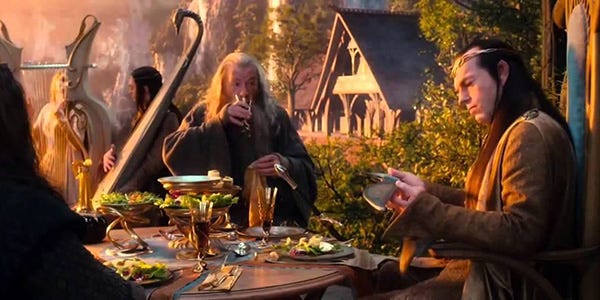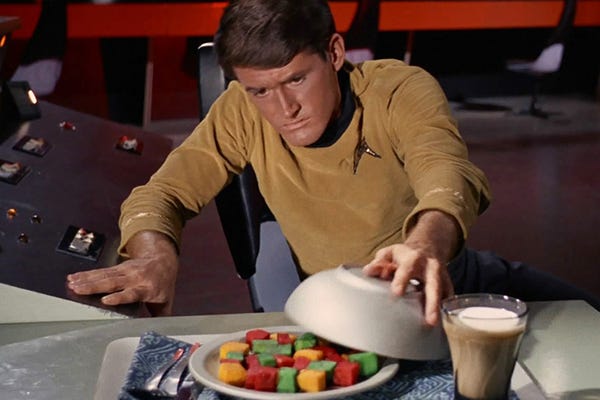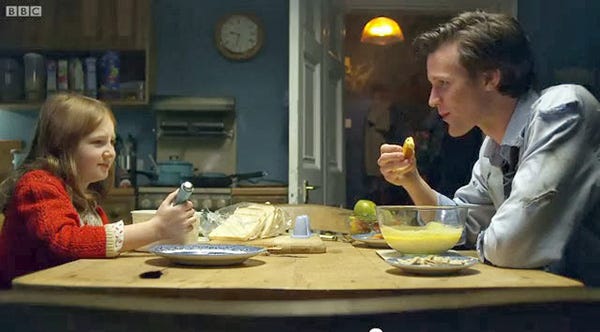Flavor and Fiction: The Power of Food in SciFi and Fantasy Worlds
From Bantha milk to Butterbeer, the culinary delights of our favorite storyworlds
There are many aspects of fictional worldbuilding, from how the environment looks and feels to who the characters are and how they interact. One of the most exciting things about fantastical fictional worlds is the food that exists within it. Creators who build worlds have an opportunity to make up their own culinary profiles that communicate the ideals, conditions, desires, and lifestyles of the world itself and the characters that inhabit it. We put together just a few of the fictional worlds whose cuisine we are fascinated by–and we want to hear from you in the comments about the foods you’d love to try from your favorite fictional worlds!
Hogwart’s
In the Harry Potter book series and movies, we are brought into the world of Hogsmeade and Hogwart’s in part via the food found there. The food of Hogwarts is as magical as the school itself, offering a blend of hearty British cuisine and whimsical wizarding treats that make mealtimes at the castle an enchanting experience. Meals are served in the Great Hall, where house-elves prepare and deliver the feasts: classic British dishes such as roast beef, Yorkshire pudding, and shepherd’s pie, all served in endless quantities. Daily meals at Hogwarts are equally inviting, with a spread of porridge, eggs, bacon, sausages, and toast for breakfast, and a variety of soups, sandwiches, pies, and puddings for lunch and dinner. And desserts at Hogwart’s are magical as well: Hogwarts desserts are legendary, with treacle tart (Harry's favorite), jam roly-poly, and chocolate gateau among the many choices. The dessert table is a wonderland of puddings, trifles, and cakes, often complemented by magical creations like self-stirring custards or levitating sweets. In Hogsmeade, students indulge in snacks and treats such as Chocolate Frogs, Bertie Bott's Every Flavor Beans, Pumpkin Pasties, and Cauldron Cakes. Butterbeer and pumpkin juice are popular drinks, offering a comforting sweetness that complements the wizarding world's magical atmosphere. These treats are so indicative of the world that The Wizarding World of Harry Potter in Universal theme parks around the world have the food and drink available to purchase and taste, bringing Hogsmeade fully to life for visiting fans.
Willy Wonka’s factory
In Willy Wonka & the Chocolate Factory, the title itself conjures an image of how the world will be set up. The idea of a chocolate factory brings together the sweet and the technical, transforming a factory into a fantastical, immersive landscape. In the story, every part of the factory is designed to be edible, whimsical, and outlandishly creative, with details like the Chocolate River, the Everlasting Gobstoppers machine, and the Fizzy Lifting Drinks room showcasing the endless possibilities of Willy Wonka’s confectionary genius. In this story, food is both part of both the worldbuilding and a metaphor. Each edible item reflects Wonka’s eccentricity and brilliance while highlighting different themes—abundance, indulgence, curiosity, and the consequences of unchecked desires. Visitors to the factory, the children in the movie, find their virtues tested as they encounter different items, and their true personalities are drawn out in their desire for more. Food serves as a lens for Wonka’s philosophy, capturing his playful, but also dark perspective on childhood, greed, and innocence. The unique, otherworldly sweets and their surreal surroundings make the factory a character in its own right, amplifying the story’s magic and moral undertones.
The Shire from Lord of the Rings
In The Lord of the Rings, food is one of the elements used to differentiate between worlds, specifically The Shire and the rest of Middle-earth. In the Shire, food is abundant and simple—rooted in fresh, wholesome ingredients from the land to which the hobbits who live there feel connected. Hobbits take pride in their gardens, and farms, and celebrate food with regular, hearty meals, often gathering for “elevenses” or “second breakfast.” They value homegrown produce, well-stocked pantries, and shared comfort meals that emphasize community and joy. Meals are often leisurely, communal, and grounded in agrarian traditions–like fresh-baked bread, meats, cheeses, and ale–embodying the Hobbits’ peaceful, unhurried way of life. The food of the Shire gives the story a deeply rooted sense of home, safety, and warmth that makes the Hobbits’ adventures throughout the series even more poignant.
Middle-earth from Lord of the Rings
In contrast to the Shire, food throughout the wider world of Middle-earth is often more practical, scarce, and survival-driven, especially in places where life is shaped by conflict or hardship. The Elves of Rivendell and Lothlórien favor ethereal, sustaining foods like “lembas” bread, or “waybread,” a light bread yet so nutritious that a single bite can sustain a traveler for an entire day. This elegant, minimalistic approach to food reflects Elven wisdom of self-sufficiency, deep connection to nature, and almost mystical approach to sustenance. Dwarves of Erebor, on the other hand, enjoy hearty, meat-heavy meals, often paired with ale, befitting their rugged, industrious nature. They feast on roasts, stews, and hard breads suitable for their underground lifestyle, and their brewing skills are highly prized. Their cuisine mirrors their practical, hard-working culture, as well as the toughness required for life in the mountain halls.
For the travelers on the quest, food becomes simple, portable, and essential for survival, with rations and dried meats, emphasizing danger of the world beyond the Shire. Simpler, rustic diets focused on sustenance rather than luxury exist in Rohan and Gondor. Rohan, a land of grassy plains and horsemen, emphasizes hearty, farm-based foods such as meats, cheeses, and bread. Gondor’s diet is more diverse, with access to river fish, fresh vegetables, and grains, but still focuses on simplicity, reflecting the resilience needed in these fortified realms. Rangers, like Aragorn, and other travelers live off the land, relying on portable foods and foraged supplies. They eat game meats, roots, dried fruits, and sometimes lembas, embodying their adaptability and the solitary, rugged lifestyle of those who roam Middle-earth. And finally, in Mordor, a barren land devoid of fresh, nourishing food forces orcs and soldiers sustain themselves on crude, unappetizing rations like dried meats and field provisions. The harshness of their food reflects the oppressive, desolate nature of Sauron’s rule.
Star Wars Galaxy
The Star Wars galaxy is vast, and its diverse planets, species, and cultures bring an equally varied array of foods, creating a rich culinary tapestry that mirrors the galaxy’s complexity. Just some of the iconic foods and drinks that add flavor to the Star Wars universe include blue milk, or bantha milk, is a staple on Luke Skywalker’s Tatooine. There’s also green milk, introduced on Ahch-To in The Last Jedi, which adds to the mystical allure of Jedi lore. “Spice,” an illicit substance found in areas like Kessel, influences both food and culture, often reflecting the seedier underbelly of the galaxy. The cantina culture features drinks like Spotchka, a blue-hued alcoholic drink, and Corellian ale, showing how socializing and entertainment vary across planets. Drinks like these often signal a character’s background or social standing.
Made by Yoda on Dagobah, rootleaf stew is a simple yet hearty meal made from plants and roots found in the swampy environment. It captures the Jedi Master’s resourceful lifestyle and the simplicity of living in harmony with nature. The roasted porg in The Last Jedi, prepared by Chewbacca, is a playful example of the varied diets across the galaxy. Other cultures, such as the Togrutas and Twi’leks, are known for their unique animal-based dishes that reflect the ecosystems of their home planets. On the forest moon of Endor, chicken-like creatures such as Tip-Yip are cooked and eaten in various forms. Fried Endorian chicken is a popular comfort food, especially in places like Batuu’s Black Spire Outpost, reflecting a blend of earth-like cuisine with a galactic twist. Many planets with lush landscapes, like Naboo, Felucia, and Kashyyyk, are home to vibrant fruits, vegetables, and plants. Yobacca fruit is a staple for the Wookiees, and lush greens from Felucia are integrated into unique plant-based meals.
On some planets, especially in wealthier regions like Coruscant, indulge in decadent treats. Jogan fruit parfaits are layered, visually appealing desserts that showcase the galaxy’s culinary creativity. There are also colorful desserts like fizz-candy and sweet-sand cookies, adding an element of fun to the galaxy’s food scene. In stark contrast, for Jedi, soldiers, and those traveling through space, food capsules and synthesized meals are quick, efficient, and easily stored. Often flavorless, these foods are geared towards function rather than enjoyment, reflecting the disciplined and often transient lifestyles of the galaxy’s warriors and explorers.
Avatar’s Four Nations Cuisine (Avatar: The Last Airbender)
The four nations in Avatar: The Last Airbender each have distinctive cuisines that reflect their cultures, elemental connections, and resources. The Water Tribes, located in the icy poles, rely on the sea for sustenance, leading to a diet rich in seafood like fish, seaweed, seal jerky, and whale blubber as well as stews and soups. Water Tribe food embodies a sense of resilience, community, and respect for nature. The Earth Kingdom’s vast and fertile lands allow for a wide range of fresh produce, grains, and meats, leading to a diverse and hearty cuisine like dumplings, rice dishes, stir-fries, and savory buns, which are often prepared with root vegetables and greens. The city of Ba Sing Se is known for its tea culture, with Uncle Iroh’s tea shop serving jasmine and ginseng teas, highlighting the kingdom’s appreciation for simplicity and tradition. Fire Nation cuisine reflects its people’s bold, intense spirit, with a penchant for spicy and flavorful foods. Dishes often feature grilled meats, exotic fruits, spicy peppers and sauces, and ingredients with a “fiery” kick, like the fire flakes snack. Meals are often grilled or roasted, symbolizing their control over fire and their intense, energetic lifestyle. And the Air Nomads, who are vegetarian due to their peaceful, spiritual beliefs, base their diet on simple, plant-based foods that include fruits, vegetables, grains, and dairy, often made into light dishes like playful fruit pies, rice, and vegetarian stews. The nomads' light, portable foods suit their minimalist, monastic lifestyle and reflect their philosophy of non-attachment and harmony with nature.
Star Trek
In Star Trek, food plays an intriguing role in illustrating the cultures, technologies, and ideals of various species across the galaxy, showing the Federation's inclusivity, the distinctive traditions of different species, and the interactions between diverse cultures. In the Star Trek universe, replicators are devices that create food from raw matter capable of producing almost any dish requested, which allows for efficient and diverse meals, and supports the Federation’s commitment to exploration and reducing resource waste. Classic replicator orders like “Tea, Earl Grey, hot”—a favorite of Captain Jean-Luc Picard—illustrate the convenience and personalization possible in the 24th century, and the technology allows crew members from different species and backgrounds to enjoy meals from their home cultures.
Klingon food is known for its bold flavors and emphasis on raw or minimally cooked dishes, embodying the warrior culture’s respect for strength and bravery. Dishes like gagh (live serpent worms), rokeg blood pie, and bregit lung are often served with little seasoning to highlight natural flavors, reflecting Klingons’ close connection to their traditions. Eating foods like live gagh is seen as an act of courage, reinforcing the Klingon focus on honor and bravery. Vulcans, who adhere to logic and a vegetarian diet, favor simple, balanced foods, like plomeek soup, a mild and minimalistic dish that reflects the Vulcan philosophy of temperance and control.
Hasperat is a spicy Bajoran dish known for its powerful kick, often compared to a very spicy wrap or burrito. It’s prepared with pickled vegetables, seasoned to create a strong, almost overwhelming flavor. Hasperat symbolizes Bajoran resilience and pride, often seen as a comfort food tied to Bajoran heritage and identity, especially in times of hardship or occupation. Ferengi cuisine, like tube grubs (sometimes eaten live) and beetle snuff, reflects the Ferengi’s unconventional and profit-driven culture. Tube grubs, a delicacy among Ferengi, demonstrate their tolerance for unusual textures and tastes, contrasting with more mainstream Federation tastes. Ferengi food customs show a willingness to embrace the unusual and represent their economic-based, self-serving society.
As for beverages, Romulan ale is a potent, blue alcoholic beverage that’s illegal within the Federation due to tensions with the Romulan Empire. Despite this, Romulan ale is highly sought after by Starfleet officers for its rarity and strength. Its appearance at special gatherings, such as diplomatic events or celebrations, signifies moments of friendship or rebellion, showing that food and drink can transcend political boundaries, even in space. Synthehol is an alcohol substitute used in the Federation that mimics the effects of alcohol without the negative side effects, like hangovers. It allows for social drinking without impairing duty, reflecting the Federation's preference for moderation and efficiency. However, some characters (especially non-Federation) prefer “the real stuff,” underscoring the cultural diversity and resistance to certain technological advances. And Raktajino, a Klingon coffee blend, became popular on Deep Space Nine. Raktajino symbolizes cultural exchange, especially on a bustling space station with a blend of species and customs.
Starfleet personnel encounter unique alien delicacies, from the brightly colored jumja sticks of Bajor to the exotic fruits of distant worlds, and sampling new foods is often an expression of open-mindedness and curiosity about other cultures, reinforcing the Federation’s values of exploration and mutual respect. Still, Earth foods like pizza, burgers, and pasta remain popular aboard Federation starships, reflecting the enduring nature of human culture. In Deep Space Nine, Sisko’s father runs a Creole restaurant in New Orleans, showcasing traditional family recipes and celebrating heritage. Human foods symbolize comfort, tradition, and nostalgia for Earth, and they bridge cultural gaps, as alien crew members often try and enjoy them–and this helps establish the Star Trek world as one that is consistently open to diversity.
Doctor Who Galaxy
Food in Doctor Who is often a quirky and imaginative element, reflective of the show's whimsical, time-traveling nature. Given the vast variety of alien species, planets, and time periods that the Doctor and companions visit, food becomes an essential aspect of the world-building. Since there are many doctors and many stories told throughout the long-running series, the food choices are vast. Some doctors have their own favorite foods, like "fish fingers and custard," a combination beloved by the Eleventh Doctor, symbolizing his eccentric personality as it is a bizarre and endearing choice. The Tenth Doctor is known for his love of cheese sandwiches, a straightforward food that reflects his occasionally childlike personality, especially when the chaos of time travel and saving the universe gets overwhelming. And because the Doctor often encounters historical figures and explores different time periods, the culinary experiences of that time and place immerse viewers further into the world. Similarly, the Doctor and companions often encounter alien food in various forms—some edible and others quite strange, like processed rations or… blood, from the Plasmavore alien species, human bacon from the Slitheen alien criminals, or parasitic sustenance from the Zygons. Sontarans—a warrior species—are shown to have their own way of preparing meals that reflect their militaristic and utilitarian culture. Though the details of their cuisine are sparse, it's likely that their food, like their warriors, is designed for practicality rather than enjoyment, focusing on nutrition and efficiency, like Sontaran space soup.
Want to do more with your fandom? Our Discord is where you’ll find everything you need to know about our fandom-forward ecosystem at Remarkist! Don’t forget to follow us on Instagram, tumblr, and Spotify for more storyworld content—and hit that subscribe button so you never miss a thing at rmrk*st Mag!













